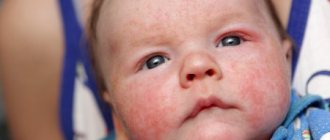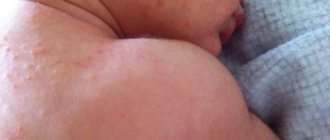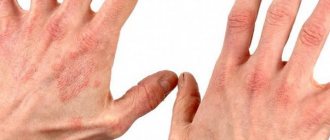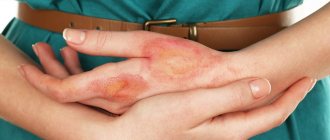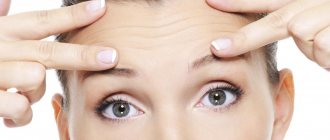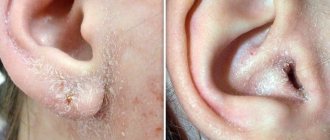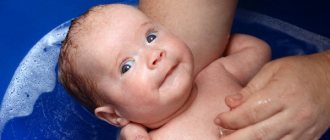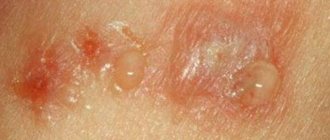Many parents have had to deal with diaper rash and rashes on the buttocks of a small child. This is due to the structural features of the skin of young children - any friction, wet environment, poor-quality diapers can cause an inflammatory process. Diaper dermatitis in the photo looks like spots and peeling of different sizes, the color can be from pale pink to red. How to avoid the appearance of dermatitis? What medications are safe for children's skin?
Photos of contact dermatitis: symptoms and treatment Photos of perioral dermatitis: symptoms, causes and treatment Causes and symptoms of exfoliative dermatitis, treatment Seborrheic dermatitis of the scalp: what is it? Treating allergic dermatitis at home
Diaper dermatitis - what is it?
Diaper dermatitis occurs when the skin comes into contact with diapers; the disease is diagnosed in children under 2–3 years of age, until the child learns to control the process of urination. The disease is widespread, occurring in 30–60% of children. The peak of pathology occurs at the age of 4–6 months, when babies begin to actively move.
Diaper dermatitis is often a sign or consequence of other pathologies:
- atopic dermatitis - appears in different parts of the body, gradually descends to the groin area, while the child constantly itches;
- abrasions - occur when the diaper size is incorrectly selected, quickly disappear without any treatment when changing the diaper size;
- seborrheic dermatitis - appears on the scalp in the form of a bright red rash, gradually moves to the buttocks;
- perianal - often occurs in babies who are bottle-fed, the rash is localized in the anus.
Important! Sometimes, simply changing the brand of diaper is enough to eliminate diaper dermatitis.
How does the treatment process for candidiasis dermatitis proceed?
Treatment of adolescents, as well as older children, is carried out taking into account the area where the rash is localized. In ordinary cases, vitamins, antihistamines, and a balanced diet are prescribed. Doctors are also trying to establish the main reason that led to the onset of dermatitis in this particular form.
Among the popular medicines, it is worth highlighting only a few. Quite often, patients use levorin, nystatin, natamycin, and other medications. For internal use, drugs are usually prescribed that are intended for use in cases of persistent candidiasis. Drugs are also prescribed for generalized forms, when the defenses of the entire body begin to decline.
Locally, antifungal ointments, various gels, and creams have reached widespread use. In this case, many patients and doctors prefer drugs produced using modern technologies. The process of treating candidal dermatitis when using topical products may require applying them two to three times during a daily period (the period can last several weeks). In a larger percentage of cases, after the end of the week, the skin is completely normalized. However, we should not forget that the calluses themselves can cause an allergic reaction. For this reason, you should use them only if they have been prescribed to you by a doctor who closely monitors the entire treatment process.
In the process of combating film-type dermatitis, it is often recommended to use belanthene and panthenol. Only in the most rare cases, candidiasis-type dermatitis, which manifests itself in infants, may require the use of systemic antifungal drugs.
Forecast
The prognosis for cure depends on many factors, such as the stage of the disease, burden of other diseases, and the cause of skin inflammation. In the mildest cases, it is enough to rule out the root cause, and the redness will go away in a few days. With proper further care for the child, a relapse will not occur.
More complex and severe cases of this disease require qualified assistance and specialist supervision, correct medication prescriptions with the possibility of further adjustments. In such cases, recurrences of the disease, as a rule, also do not occur.
The risk group for relapses includes children with congenital or acquired pathologies of the gastrointestinal tract, a weak immune system, the presence of atopic dermatitis and antisocial parents.
By following all the necessary measures and rules for caring for a small child, you can avoid the occurrence of such an unpleasant disease as diaper dermatitis. But if diaper rash or rashes appear on your baby’s skin, you need to review and adjust his care. A pediatrician can easily help parents with this.
Complications and prognosis of film dermatitis
Skin infection is a common complication due to improper treatment. In addition, the child may experience additional complications.
- Abscess.
- Candida dermatitis.
- Infiltrate.
- Sleep disturbance.
- Loss of appetite.
- Increase in body temperature to 40 degrees.
If these signs are detected, you should immediately consult a doctor.
As for the prognosis, the disease with a mild course goes away on the 3rd - 4th day. In more severe cases, the disease lasts longer. This will require consultation with specialized specialists: gastroenterologist, immunologist and allergist.
Causes
The main cause of diaper dermatitis is prolonged skin contact with a wet diaper. Urine does not evaporate; inflammation begins against the background of the skin being exposed to uric acid and other substances that are part of urine and feces. The simultaneous impact of urine and feces on the skin is also important - this leads to an increased damaging effect.
The following factors can provoke the appearance of film dermatitis:
- neglect of hygiene rules;
- allergic reaction to detergents and chemical products;
- individual intolerance to children's cosmetics;
- poor quality diapers that do not allow air to pass through;
- concomitant pathologies, diathesis;
- incorrect diaper size, and, as a result, mechanical friction of the skin;
- contact with microbes.
Candidiasis diaper dermatitis occurs in children as a result of skin damage by fungi of the genus Candida after antibacterial therapy; it often occurs in babies who are bottle-fed.
The cause of the disease can be some features of the body - atopic predisposition, high ammonia content in the urine, weak immunity, diarrhea.
Important! Many people think that diaper irritation occurs, but in fact, high-quality diapers can significantly reduce the incidence of the disease and the degree of its manifestation.
The role of diapers in the development of dermatitis
The advent of disposable diapers has greatly simplified the lives of parents. Practicality and comfort are the main advantages of diapers.
There is an opinion that regular use of diapers harms the baby’s healthy skin: it causes diaper rash, redness and itching, which subsequently leads to the development of diaper dermatitis. Actually this is not true. There are no adverse effects when diapers are used correctly.
When choosing a diaper, you need to consider the following nuances:
- Choose the right size;
- Change the diaper in a timely manner (every 3-5 hours);
- Choose diapers that do not contain lotions or various fragrances.
Attentive attitude towards the child, the correct choice of diapers, adherence to the rules of hygiene and prevention of skin diseases make it possible to use disposable diapers without causing harm to the child’s health.
Kinds
Diaper dermatitis in pediatrics is divided into several types:
- Candidiasis - in an infant, a fungal inflammatory process caused by candida is usually concentrated in the groin area. The risk group includes premature babies who have undergone a course of antibiotic therapy.
- Perianal – diaper rash occurs in the anal area. The pathology is associated with digestive disorders in a child. If he is fed formula, the feces become alkaline.
- Regional is the most “harmless” type of disease. Occurs when the diaper rubs against the baby's skin.
- Seborrheic – the newborn’s perineum becomes covered with crusts. Left untreated, inflammation spreads throughout the body.
- Atopic dermatitis is a pathology accompanied by inflammation of the perineum, itching, redness of the skin, and peeling.
- Intertrigo is a bacterial type of inflammatory process caused by bacteria - staphylococci, streptococci. The baby's skin becomes covered with blisters, which later turn into scarring skin lesions.
Please note that only a pediatrician can make an accurate diagnosis and identify exactly what type of dermatitis a child has.
Symptoms
Diaper dermatitis occurs in areas of skin contact with feces and urine - buttocks, genitals. What does this type of dermatitis look like? At the initial stage, redness, blisters, and peeling appear on the skin. If the pathology is left unattended, the blisters can turn into ulcers with pus, spread to the back and abdomen, and severe swelling appears.
Signs of diaper dermatitis:
- the rash does not go away for more than 4 days, has a clear border, peeling layers of the epidermis are visible;
- the baby becomes restless, constantly reaching for the diaper, trying to take it off;
- Often the disease occurs when new foods are introduced into the child’s diet.
Important! A distinctive feature of ordinary diaper dermatitis from other types (candidiasis, seborrheic, atopic) is that with this type of dermatitis the folds of the skin are almost never affected.
The diagnosis is made on the basis of an external examination, the results of a clinical blood test, and a stool test for dysbacteriosis to determine the specific type of pathogen.
When is it necessary to urgently take your child to the doctor? Sometimes diaper dermatitis can be a symptom of serious pathologies. Urgent medical attention is needed if the baby has a fever, the rash turns purple-blue, or the child has purulent discharge and ulcers.
Symptoms of candidal dermatitis
Symptoms of candidal dermatitis:
- Redness of the skin.
- Itching and burning.
- Localization of symptoms: genitals (diapers are located there). It becomes difficult for the patient to go to the toilet, and his body temperature often rises. The disease can expand in the affected area to the back and abdomen, the foci of the disease itch and burn more intensely. This brings a lot of unpleasant sensations to the child, which is why he may begin to be capricious, cry, refuse to eat, and become weak and drowsy. The patient's itching does not stop. The child becomes nervous because he cannot rest properly due to constant itching.
Symptoms appear sequentially. At first there is a slight itching, the skin begins to turn red. The child is not very worried at this stage, but gradually the symptoms intensify. For a child, diapers only worsen the situation; they rub the skin; the synthetic composition of diapers causes severe redness. The symptoms are more pronounced, the disease brings pain. The skin between your legs chafes and blisters appear. Then the blisters open and fluid comes out. The areas with them become rough, crusty, and then itchy again.
The very last stage is called diaper dermatitis. With it, the affected area increases: the itching spreads to the genitals, stomach and back. The patient cannot go to the toilet, the body temperature rises, the child stops sleeping and eating. Bringing your child to this stage is very dangerous.
Photos of symptoms of candidal dermatitis in adults and children, children, infants on the face and hands can be viewed in a special section on the page.
Symptoms
This skin inflammation occurs most often on the buttocks, groin area and inner thigh. It can affect both small areas of the epidermis and a fairly large area, depending on the stage and duration of the inflammatory process.
The main symptoms include:
- Redness of the skin of the buttocks, groin, inner thigh, genitals, or anus. It often spreads to the child's hips and lower back.
- The main and bright redness occurs under the diaper , gradually becoming lighter and moving to the healthy dermis, that is, there are no clear boundaries between the affected area and the healthy one.
- Uneven redness. It is most pronounced at the edges of the diaper. With loose stools - around the anus. In the natural folds of the baby's skin, redness may be completely absent or have a faint color.
- Swelling of the dermis. The affected area feels denser to the touch than healthy skin.
- The affected areas are uneven, shapeless , and at an advanced stage they can increase in size and merge.
- The presence of small weeping wounds and cracks on which non-healing crusts may appear.
- Rash , mild or severe, depending on the stage.
- Blisters that may burst, forming oozing spots.
- In some cases, dermatitis, on the contrary, can manifest itself as dryness and flaking of the skin , the formation of white and yellow scales.
Dry skin All these symptoms cause great discomfort to the baby, because he experiences burning and itching in the inflamed areas of the skin. The baby may cry for a long time, be capricious, refuse to eat, and his sleep is disturbed. There is often no temperature; its presence indicates a possible infection and requires immediate medical attention.
Treatment methods
If treatment for diaper dermatitis is not started on time, then secondary infections will begin to appear against its background, and the inflammatory process will begin to penetrate into the inner layers of the epidermis.
Important! Dr. Komarovsky says that frequent air baths will help quickly cure dermatitis at the initial stage. Children's skin has the ability to recover very quickly - if the cause of irritation is eliminated, the disease will disappear within a few days.
How to treat diaper dermatitis in children:
- At the initial stage, you should treat the skin with a 2% solution of brilliant green; it is better to sprinkle the affected areas not with talcum powder, but with Baneocin powder.
- When diagnosing fungal diaper dermatitis, the doctor will help you choose an antifungal ointment - Ecodax, Travogen. From the first days of life you can use Nystatin, Pimafucin. The products should be applied to clean, dry skin twice a day. Duration of therapy is a week.
- Drying ointments – Desitin.
- Preparations for restoring the epithelium and improving protective functions - Bepanten, D-Panthenol.
- Panthenol Spray will help speed up the regeneration process. It can be used to treat infants.
Important! Do not use powders and ointments on the same affected areas at the same time.
For the treatment of adults, antibacterial agents are used - Nystatin, Levorin. Additionally, tablets and ointments from the azole class are prescribed - Ketoconazole, Itraconazole. Antifungal ointments and creams should be applied to the skin 2-3 times a day. Duration of therapy is 14 days.
Folk remedies
Non-traditional treatment methods effectively help relieve a child from itching, flaking; decoctions soften the skin and eliminate inflammatory processes.
The most popular method for treating diaper dermatitis is an oat bath. Brew 250 ml of 25 g of crushed raw materials, strain after half an hour, pour into the baby’s bathing water. The duration of the procedure is 15 minutes.
As an emergency aid to eliminate severe itching, you can use raw potatoes - peel the vegetable, grind it in a blender, apply the pulp to the affected areas for 25 minutes, remove the residue with a damp cotton pad. To enhance the effect, the potato mass can be mixed with an equal amount of chopped celery root.
For the treatment and prevention of film dermatitis and other skin rashes, you can use string, chamomile, and celandine. From the herbs you need to prepare an infusion of 20 g of dry raw materials and 220 ml of boiling water, leave in a closed container for half an hour, pour into a bath, and bathe the baby.
St. John's wort oil helps to quickly cope with inflammatory processes on the skin - grind 30 fresh herbs, pour in 200 ml of olive oil, put the mixture in a warm place for 14 days, stir daily. Apply the medicine to the affected areas twice a day.
Fungal diaper dermatitis - treatment, ointments and creams
Treatment of candidal dermatitis is carried out with antifungal drugs. But it must be remembered that in each case, treatment must be prescribed by a doctor and selected individually in each situation, depending on the severity and general condition, taking into account all factors. It is also important to remember that an allergic reaction to the drug is always possible.
For mild severity, external use of antifungal ointments and creams is sufficient. External products are applied twice a day to clean, dry skin. It is important to remember that they must continue to be applied for another 7 days after the rash has completely disappeared.
are effective :
- clotrimazole;
- miconazole;
- mycosolone;
- nizoral;
- amiclone;
- antifungol;
- ecodax.
The above ointments affect not only fungi of the genus Candida, but also dermatophytes, yeast-like, mold fungi, staphylococci, streptococci and some gram-negative bacteria.
Nystatin and pimafucin are often prescribed. Sometimes there is an effect of treatment with these drugs. But the drugs are already about 60 years old and many mushrooms have already developed resistance to them, so in most cases they are ineffective.
In more severe cases, it is necessary to take oral or injectable forms of antifungal drugs (fluconazole, ketoconazole).
But candidiasis diaper dermatitis, like any disease, is easier to prevent than to treat.
Prevention of diaper dermatitis
In addition to timely treatment of dermatitis, you need to know how to prevent the development of the inflammatory process.
Preventive actions:
- frequent changes of diapers and diapers - diapers need to be changed every 3-4 hours, regardless of the time of day;
- do not use waterproof diapers - candidal dermatitis always develops in conditions of high humidity;
- choose high-quality diapers, purchase them in pharmacies and specialized points of sale;
- After each bowel or bladder movement, the baby must be washed with warm water and neutral soap.
To avoid the appearance of skin rashes, the child must be dressed according to the weather, and the air in the room must have optimal temperature and humidity levels.
Diaper dermatitis is a common disease among young children, but parents can prevent its occurrence. The basic rules are to follow hygiene rules, use high-quality diapers, and often give the baby air baths.
Causes
Candidal dermatitis develops due to insufficient hygiene. For example: parents did not attach due importance to caring for a child or a bedridden patient (they rarely washed the baby, did not change diapers in a timely manner, etc.).
Other reasons may include the following:
- increased skin moisture;
- hereditary predisposition (not only to dermatitis, but also to allergic reactions);
- treatment with antibiotics, especially in cases where an adult or child does not receive additional drugs that restore the natural intestinal microflora;
- heat;
- prolonged contact of the skin with feces or urine;
- poor nutrition.
Mandatory conditions for a child’s recovery
Maintaining hygiene procedures and performing simple manipulations will help your baby not get sick or quickly cope with the onset of an illness. Such procedures include:
- washing the baby with warm water after each bowel movement;
- frequent diaper or diaper changes. For a newborn it is necessary to change it after each trip to the toilet, for older children - 3-4 times a day;
- diapers must be purchased strictly according to size so that they do not press or rub the baby’s delicate skin. They also need to be made of natural cotton material with gel filler;
- It is better to avoid alkaline soap, as it dries the skin;
- for the period of treatment, exclude fermented milk products, juices and fruits from the diet;
- After washing, iron the baby’s clothes and diapers well;
- Always wash your hands before touching your baby.
Prevention measures
Diaper dermatitis in children from birth can be completely avoided if parents:
- be more scrupulous in the choice of diapers and diapers, buy from soft, breathable materials, without tight and constricting elastic bands;
- wash the child with running water after each diaper change;
- use baby soap for hygiene;
- select diapers according to size so that they do not rub the skin and do not provoke the development of pathology;
- keep your baby's skin dry and clean;
- remove residual moisture with a napkin after each wash;
- treat skin areas in the groin and buttocks that are prone to redness and chafing with baby cream;
- Regularly carry out air baths to allow the baby’s skin to breathe.
Diaper dermatitis disrupts the sleep-wake pattern of babies and causes a lot of anxiety. It flares up more often when hygiene rules are not followed, dietary habits are used, or a wet diaper or poor-quality cosmetics occur.
Children under 3 years of age cannot take care of themselves, and therefore are at risk. The disease is treated quickly at an early stage. But it is important to carry out therapy correctly, using lotions, ointments, creams, decoctions and lotions from medicinal plants and fresh vegetables only after consultation with the doctor.
